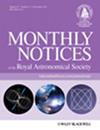Gamma-ray Blazar Classification using Machine Learning with Advanced Weight Initialization and Self-Supervised Learning Techniques
IF 4.7
3区 物理与天体物理
Q1 ASTRONOMY & ASTROPHYSICS
引用次数: 0
Abstract
Machine learning has emerged as a powerful tool in the field of gamma-ray astrophysics. The algorithms can distinguish between different source types, such as blazars and pulsars, and help uncover new insights into the high-energy universe. The Large Area Telescope on-board the Fermi Gamma-ray telescope has significantly advanced our understanding of the Universe. The instrument has detected a large number of gamma-ray emitting sources, among which a significant number of objects have been identified as active galactic nuclei. The sample is primarily composed of blazars; however, more than one-third of these sources are either of an unknown class or lack a definite association with a low-energy counterpart. In this work, we employ multiple machine learning algorithms to classify the sources based on their other physical properties. In particular, we utilized smart initialisation techniques and self-supervised learning for classifying blazars into BL Lacertae objects (BL Lac, also BLL) and flat spectrum radio quasars (FSRQ). The core advantage of the algorithm is its simplicity, usage of minimum number of features and easy deployment due to lesser number of parameters without compromising on the performance along with increase in inference speed (at least 7 times more than existing algorithms). As a result, the best performing model is deployed on multiple platforms so that any user irrespective of their coding background can use the tool. The model predicts that out of the 1115 sources of uncertain type in the 4FGL-DR3 catalog, 820 can be classified as BL Lacs, and 295 can be classified as FSRQs.利用先进权重初始化和自我监督学习技术的机器学习进行伽马射线耀斑星分类
机器学习已成为伽马射线天体物理学领域的一个强大工具。这些算法可以区分不同的源类型,如炽星和脉冲星,并有助于揭示对高能宇宙的新认识。费米伽马射线望远镜上的大面积望远镜极大地推动了我们对宇宙的认识。该仪器探测到了大量的伽马射线发射源,其中相当多的天体被确定为活动星系核。样本主要由炽星组成;然而,这些源中有三分之一以上要么属于未知类别,要么缺乏与低能对应物的明确联系。在这项工作中,我们采用了多种机器学习算法,根据源的其他物理特性对其进行分类。特别是,我们利用智能初始化技术和自我监督学习将类星体分为 BL Lacertae 天体(BL Lac,也称 BLL)和平谱射电类星体(FSRQ)。该算法的核心优势在于其简易性、使用最少的特征数量、因参数数量较少而易于部署,同时还能提高推理速度(至少是现有算法的 7 倍)。因此,性能最好的模型被部署在多个平台上,这样任何用户,无论其编码背景如何,都可以使用该工具。该模型预测,在 4FGL-DR3 星表中的 1115 个不确定类型的源中,有 820 个可归类为 BL Lacs,295 个可归类为 FSRQs。
本文章由计算机程序翻译,如有差异,请以英文原文为准。
求助全文
约1分钟内获得全文
求助全文
来源期刊

Monthly Notices of the Royal Astronomical Society
ASTRONOMY & ASTROPHYSICS-
CiteScore
9.10
自引率
37.50%
发文量
3198
审稿时长
3 months
期刊介绍:
Monthly Notices of the Royal Astronomical Society is one of the world''s leading primary research journals in astronomy and astrophysics, as well as one of the longest established. It publishes the results of original research in positional and dynamical astronomy, astrophysics, radio astronomy, cosmology, space research and the design of astronomical instruments.
 求助内容:
求助内容: 应助结果提醒方式:
应助结果提醒方式:


